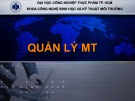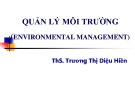
9/26/2016
1
Chapter 2:
INDUSTRIAL HYGIENE
Vietnam National University –HCMC
Ho Chi Minh City University of Technology
Faculty of Resource & Environment
Lecturer: Dr. TRAN BICH CHAU
Email: tbchau@hcmus.edu.vn
02/2016
1. What is Occupational/Industrial Hygiene?
2. Four steps to create healthy working place (A.R.E.C):
–Anticipation
–Recognition
–Evaluation
–Control
3. Factors affecting to industrial hygiene:
–Chemical hazards
–Physical agents
–Biological hazards
–Ergonomic hazards
OUTLINE: INDUSTRIAL HYGIENE

9/26/2016
2
Industrial/Occupational Hygiene?
Interactions between people
and the environment

9/26/2016
3
INDUSTRIAL HYGIENE
OCCUPATIONAL HYGIENE
= 0r ≠
What is the diferrence between industrial hygiene and
occupational hygiene ???
Industrial hygiene is the science of anticipating,
recognizing, evaluating, and controlling workplace
conditions that may cause workers' injury or illness.
Berenice I. Ferrari Goelzer
What is Industrial Hygiene?

9/26/2016
4
What is Industrial Hygiene?
Industrial hygiene : the science of protecting
and enhancing the health and safety of
pepeole at work and in their communities.
The American Board of Inductrial Hygiene
Key factors:
- Employee exposure to hazards
- Control for hazards to protect workers
Basic principles of Industrial Hygiene
1. Anticipation of potential risks
2. Recognition of existing health hazards at the
workplace
3. Evaluation of health risks
4. Contol of unacceptable risks
Remember the acronym: A.R.E.C

9/26/2016
5
Task planning and
hazard analysis of
injury/illness, trend
analysis, reported
concerns
Inspections, exposure
assessment, modeling,
visual assessments,
professional judgment
Engineering controls,
administrative
controls, substitution,
personal protective
equipment
Review products,
purchases, projects,
tasks, designs,
experiments, etc.
Steps to
Protect
Employees
Factors affected to industrial hygiene
•Micro-climate
•Chemicals
•Noise
•Vibration
•Radiation
•Light
•Dust
•Harmful microorganism
•Ergonomic














![Quản Lý Rủi Ro Thiên Tai & Biến Đổi Khí Hậu: Tài Liệu Kỹ Thuật [Mới Nhất]](https://cdn.tailieu.vn/images/document/thumbnail/2025/20251225/tangtuy08/135x160/46811766713087.jpg)











